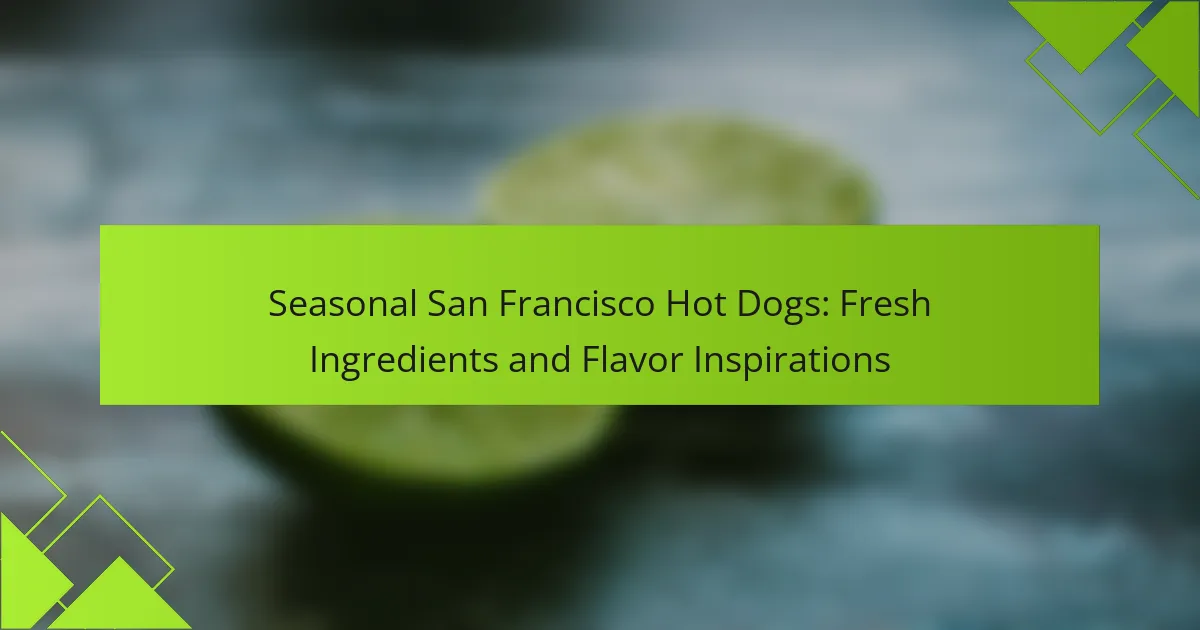Seasonal San Francisco Hot Dogs are gourmet hot dogs made with fresh, locally sourced ingredients that change with the seasons. Each hot dog is crafted to enhance flavor and provide a unique culinary experience, reflecting the availability of seasonal produce. Popular toppings include fresh avocado, seasonal salsas, and pickled vegetables, which highlight the city’s emphasis on local ingredients and diverse culinary influences. This concept not only supports sustainability but also caters to food enthusiasts seeking innovative dining options throughout the year. The article will explore the seasonal variations and regional flavors that characterize these gourmet hot dogs.

What are Seasonal San Francisco Hot Dogs?
Seasonal San Francisco Hot Dogs are gourmet hot dogs that feature fresh, locally sourced ingredients. These hot dogs change with the seasons to reflect the availability of produce. For example, summer options may include fresh tomatoes and basil, while winter varieties might incorporate hearty root vegetables. Each seasonal offering is designed to enhance flavor and provide a unique culinary experience. The concept emphasizes sustainability and supports local farmers. Seasonal San Francisco Hot Dogs often highlight regional flavors and culinary trends. They are popular among food enthusiasts seeking innovative and fresh dining options.
How do Seasonal San Francisco Hot Dogs differ from traditional hot dogs?
Seasonal San Francisco hot dogs differ from traditional hot dogs primarily in their use of fresh, local ingredients. These hot dogs often incorporate seasonal toppings that reflect the flavors of the region. For example, they may feature ingredients like artisanal cheeses, specialty mustards, or locally sourced vegetables. Traditional hot dogs typically rely on standard toppings like ketchup and mustard, lacking this regional flair. Seasonal hot dogs also emphasize unique flavor combinations inspired by local culinary trends. This focus on freshness and creativity sets them apart from the more uniform offerings of traditional hot dogs.
What unique ingredients are typically used in Seasonal San Francisco Hot Dogs?
Seasonal San Francisco Hot Dogs typically feature unique ingredients like Dungeness crab, pickled vegetables, and artisan cheeses. Dungeness crab adds a fresh, local seafood flavor. Pickled vegetables provide a tangy crunch, enhancing the overall taste. Artisan cheeses, such as aged cheddar or goat cheese, contribute rich, creamy textures. These ingredients reflect the region’s culinary diversity and seasonal availability. San Francisco’s hot dog vendors often incorporate local produce, like heirloom tomatoes and fresh herbs, to elevate the dish. Each ingredient is chosen to create a distinct flavor profile that showcases the city’s vibrant food scene.
How do seasonal changes influence the ingredients used?
Seasonal changes significantly influence the ingredients used in hot dogs. Different seasons bring variations in the availability of fresh produce. For instance, summer often features tomatoes, corn, and peppers. Fall may introduce squash, apples, and root vegetables. Winter typically sees the use of hearty greens and preserved items. Spring allows for a resurgence of fresh herbs and young vegetables. These seasonal ingredients enhance flavor profiles and nutritional value. Utilizing seasonal produce aligns with local sourcing practices, promoting sustainability. This approach supports farmers and reduces transportation emissions. Seasonal ingredient usage also reflects cultural culinary practices tied to specific times of the year.
What flavor inspirations drive Seasonal San Francisco Hot Dogs?
Seasonal San Francisco Hot Dogs are inspired by local ingredients and culinary trends. The city’s diverse food culture influences flavor profiles. Seasonal hot dogs often feature fresh produce from local farmers’ markets. Ingredients like heirloom tomatoes, artisan cheeses, and unique condiments are common. Asian, Mexican, and Mediterranean flavors frequently enhance these hot dogs. For example, kimchi or salsa can add a distinct twist. The focus on sustainability drives the use of organic and locally sourced ingredients. This approach not only supports local economies but also ensures freshness and quality.
What cultural influences shape the flavor profiles of these hot dogs?
Cultural influences such as regional cuisines, immigrant traditions, and local ingredients shape the flavor profiles of San Francisco hot dogs. For instance, the influence of Mexican cuisine introduces flavors like jalapeños and cilantro. Asian culinary traditions contribute ingredients like kimchi and teriyaki sauce. The city’s diverse population brings a variety of spices and preparation methods. Seasonal ingredients from local farmers’ markets also enhance the flavors. These elements create unique combinations that reflect San Francisco’s multicultural landscape. The result is a hot dog experience that is both innovative and rooted in tradition.
How do local events and festivals inspire flavor combinations?
Local events and festivals inspire flavor combinations by showcasing regional ingredients and culinary traditions. These gatherings often highlight local produce, meats, and spices unique to the area. Chefs and vendors create dishes that reflect the culture and history of the event. For instance, the San Francisco Cherry Blossom Festival features flavors that incorporate seasonal cherries and Japanese influences. Festivals also encourage collaboration among local chefs, leading to innovative dishes that blend different culinary styles. This exchange of ideas fosters creativity and experimentation in flavor profiles. Thus, local events serve as a platform for culinary exploration, resulting in diverse and exciting flavor combinations.
Why are fresh ingredients important in Seasonal San Francisco Hot Dogs?
Fresh ingredients are important in Seasonal San Francisco Hot Dogs because they enhance flavor and quality. Using fresh produce ensures that the hot dogs have vibrant tastes and textures. Seasonal ingredients also support local farmers and reduce transportation emissions. This practice promotes sustainability and community engagement. Additionally, fresh ingredients often contain more nutrients, contributing to a healthier meal option. Studies show that freshness can significantly impact taste perception, making dishes more enjoyable. Ultimately, fresh ingredients elevate the overall dining experience in these hot dogs.
How does freshness affect the taste and quality of the hot dogs?
Freshness significantly enhances the taste and quality of hot dogs. Fresh hot dogs typically exhibit better flavor profiles. They retain moisture and have a firmer texture. This results in a more enjoyable eating experience. Fresh ingredients also contribute to a more vibrant taste. Studies show that fresh meats contain higher levels of natural flavors. For instance, freshly made hot dogs can have a noticeable difference in taste compared to those that are pre-packaged and stored for extended periods. Overall, freshness is crucial for maximizing the sensory qualities of hot dogs.
What sourcing practices ensure the use of fresh ingredients?
Sourcing practices that ensure the use of fresh ingredients include local sourcing and seasonal purchasing. Local sourcing involves obtaining ingredients from nearby farms or markets. This practice reduces transportation time, ensuring freshness. Seasonal purchasing means selecting ingredients that are in season. Seasonal ingredients are harvested at their peak ripeness, enhancing flavor and nutritional value.
Additionally, establishing relationships with farmers fosters transparency in ingredient quality. Regular visits to suppliers can verify the freshness of products. Implementing strict quality control measures during receiving checks further ensures ingredient freshness. These practices collectively contribute to maintaining high-quality standards in food preparation.
How can consumers enjoy Seasonal San Francisco Hot Dogs?
Consumers can enjoy Seasonal San Francisco Hot Dogs by visiting local food trucks or restaurants that feature them. These hot dogs often incorporate fresh, seasonal ingredients sourced from local markets. Popular toppings may include unique condiments and vegetables that reflect the flavors of the season. Many vendors offer specialty hot dogs that change with the seasons, enhancing the dining experience. For instance, summer may feature hot dogs topped with grilled peaches and basil. Consumers can also participate in local food festivals that celebrate these seasonal creations. This allows them to taste various interpretations of the hot dog, showcasing the creativity of local chefs.

What are the most popular seasonal toppings for San Francisco Hot Dogs?
The most popular seasonal toppings for San Francisco hot dogs include fresh avocado, seasonal salsas, and pickled vegetables. Avocado adds a creamy texture and rich flavor, making it a favorite during the warmer months. Seasonal salsas often feature local produce, enhancing the freshness of the dish. Pickled vegetables provide a tangy contrast that complements the hot dog. These toppings reflect the city’s emphasis on fresh, local ingredients. San Francisco’s diverse culinary scene influences these seasonal choices, ensuring variety throughout the year.
How do different toppings enhance the flavor of hot dogs?
Different toppings enhance the flavor of hot dogs by adding contrasting textures and complementary tastes. For example, tangy mustard cuts through the richness of the sausage. Sweet relish provides a balance to savory flavors. Fresh onions add crunch and sharpness, enhancing overall taste. Spicy jalapeños introduce heat, creating a bold flavor profile. Each topping brings unique attributes, enriching the hot dog experience. According to a study by the National Hot Dog and Sausage Council, 75% of hot dog consumers prefer toppings that add flavor complexity. This demonstrates the significance of toppings in enhancing flavor.
What are the most common seasonal toppings used?
The most common seasonal toppings used for hot dogs include fresh ingredients like avocados, tomatoes, and corn. In spring, toppings often feature asparagus and radishes. Summer brings fresh basil, peaches, and various hot peppers. Fall introduces toppings such as roasted pumpkin and caramelized onions. Winter often includes toppings like sauerkraut and apple slaw. These toppings reflect the seasonal availability of fresh produce in San Francisco. Each season offers unique flavors that enhance the hot dog experience.
How do toppings vary with different seasons?
Toppings for hot dogs vary significantly with the seasons. In spring, fresh ingredients like asparagus and radishes are popular. Summer toppings often include bright flavors such as pico de gallo and avocado. Fall introduces heartier options like roasted squash and caramelized onions. Winter toppings may feature warm ingredients like chili or sauerkraut. Seasonal changes in produce availability influence these variations. Local markets provide fresh, seasonal ingredients that enhance flavor profiles. This approach supports sustainability and promotes local agriculture.
What are the best practices for making Seasonal San Francisco Hot Dogs at home?
Use high-quality, locally sourced ingredients for Seasonal San Francisco Hot Dogs. Fresh produce enhances flavor and texture. Choose seasonal toppings like grilled peppers, onions, or avocados. These ingredients are often available at local farmers’ markets. Opt for artisan hot dog brands that prioritize natural meats. Cooking methods matter; grilling or steaming hot dogs retains moisture. Serve on fresh, locally baked buns for optimal taste. Pair with unique condiments like garlic aioli or spicy mustard. This approach reflects the vibrant food culture of San Francisco.
What ingredients should home cooks prioritize for authenticity?
Home cooks should prioritize fresh and local ingredients for authenticity in San Francisco hot dogs. Using locally sourced sausages enhances flavor and supports local farmers. Fresh vegetables like heirloom tomatoes and artisan pickles add vibrant taste. Gourmet condiments, such as handcrafted mustards and aiolis, elevate the dish. Incorporating unique toppings like sauerkraut or jalapeños provides regional flair. Additionally, using fresh herbs like cilantro or basil can enhance the overall profile. Prioritizing these ingredients results in a more genuine culinary experience that reflects San Francisco’s diverse food culture.
How can cooking methods affect the final product?
Cooking methods significantly influence the texture, flavor, and nutritional content of the final product. Different techniques, such as grilling, boiling, or steaming, alter the way ingredients interact. For example, grilling hot dogs can enhance their flavor through caramelization, creating a smoky taste. Boiling may result in a softer texture, which some consumers prefer. Steaming retains more nutrients compared to other methods, preserving the health benefits of fresh ingredients. Additionally, cooking time and temperature impact the juiciness and overall quality of the hot dog. Research shows that proper cooking methods can reduce harmful bacteria, ensuring food safety. Thus, selecting the right cooking technique is essential for achieving the desired outcome in seasonal hot dogs.
What tips can enhance the experience of enjoying Seasonal San Francisco Hot Dogs?
Choose high-quality, locally sourced ingredients for your Seasonal San Francisco Hot Dogs. Fresh produce enhances flavor and supports local farmers. Experiment with unique toppings like avocado, kimchi, or seasonal vegetables. These options add variety and excitement. Pair hot dogs with local craft beers for a complementary flavor profile. This pairing is popular in San Francisco. Consider enjoying hot dogs at outdoor food markets. The vibrant atmosphere enhances the dining experience. Lastly, try different cooking methods such as grilling or roasting. These methods can bring out distinct flavors in the hot dogs.
Seasonal San Francisco Hot Dogs are gourmet hot dogs that utilize fresh, locally sourced ingredients, changing with the seasons to reflect available produce. This article explores how these hot dogs differ from traditional varieties through unique toppings and flavor inspirations, highlighting the importance of freshness and sustainability. It delves into the cultural influences shaping their flavor profiles, popular seasonal toppings, and best practices for home preparation. Additionally, the article discusses the impact of local events on flavor combinations and offers tips for enhancing the overall dining experience.
